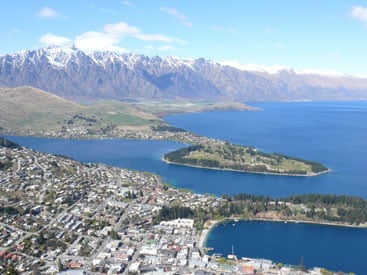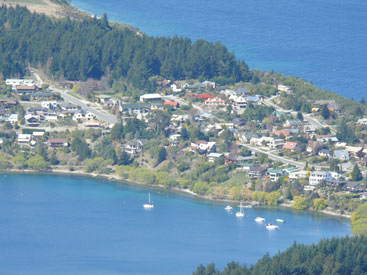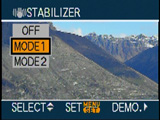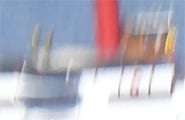Panasonic Lumix DMC-FZ50
-
-
Written by Gordon Laing
Panasonic Lumix DMC FZ50 lens coverage
Lenses and Optical stabilisation / Screen and menus / Sensor and processing
The major selling point of the FZ50 is of course its 12x optically-stabilised Leica zoom lens, which is identical to the earlier FZ30. It delivers an impressive range equivalent to 35-420mm with an optically fast focal ratio of f2.8-3.7; the actual focal length is 7.4-88.8mm. The zoom itself is operated by a tactile mechanically-linked ring, and unlike many of its rivals, the actual barrel doesn’t extend during this process. A lens hood is supplied and the front lens element doesn’t rotate during focussing, allowing easy use of polarising filters.
The 12x optical range is truly impressive in practice, with the telephoto end really pulling in distant detail, or throwing backgrounds out of focus on portraits. The wide-angle end is usable at 35mm, although many may prefer sacrificing the extreme long end for something wider, such as the 28-300mm range of the Fujifilm S9600 / S9100. Setting the lens to manual focus temporarily enlarges the central area.
To illustrate the FZ50’s coverage, we mounted it on a tripod and took photos of the same scene with the lens zoomed out to wide angle and all the way in to telephoto. These are taken from exactly the same position (albeit on different days) to the examples in our recent reviews, so are comparable in terms of coverage. For other examples, see the Canon 400D / XTi and Panasonic Lumix TZ1coverage pages.
Panasonic DMC-FZ50 coverage wide |
Panasonic DMC-FZ50 coverage tele | |
 |  | |
| 7.4-88.8mm at 7.4mm, f11 (35mm equivalent) | 7.4-88.8mm at 88.8mm, f11 (420mm equivalent) |
It’s clear the FZ50, like its predecessor has a massive optical range, and leaves the typical 3x optical zooms of DSLR kit lenses in the dust. The massive 420mm equivalent focal length is a world apart from the 80-100mm telephoto equivalent of most DSLR kit lenses when zoomed-in, and comfortably longer than even the 28-300mm range you’d get from an 18-200mm super-zoom lens on a DSLR. It’s simply an extremely flexible range to have at your disposal, especially in such a compact package. The only downside is the 35mm wide angle equivalent, when most DSLR kit lenses and even some all-in-ones offer a much wider 28mm equivalent.
Image stabilisation
Like its predecessor, the FZ50 is equipped with Panasonic’s Optical Image Stabilisation (OIS) technology for reducing camera shake. Again like other Panasonic models, there’s the choice of two OIS modes or the option of turning it off altogether; you can access the OIS options by pressing the button with an icon of a shaky hand.
 |
OIS Mode 1 applies stabilisation constantly which can greatly aid composition, especially at longer focal lengths. OIS Mode 2 only applies the stabilisation as you take the picture, which Panasonic claims better combats camera-shake, although you won’t see the effect as you compose the image. Note OIS is also available when recording movies, but only with Mode 1.
Panasonic Lumix DMC-FZ50 Mega OIS off |
Panasonic Lumix DMC-FZ50 Mega OIS Mode 1 |
Panasonic Lumix DMC-FZ50 Mega OIS Mode 2 | ||
 |  |  | ||
| 7.4-88.8mm at 88.8mm, 1/80, 100 ISO | 7.4-88.8mm at 88.8mm, 1/80, 100 ISO | 7.4-88.8mm at 88.8mm, 1/80, 100 ISO |
Above are crops from three examples of a boat taken with the lens fully zoomed-in to an equivalent of 420mm at a shutter speed of 1/80, taken with OIS disabled, followed by the two OIS modes. The original crops measured 370×240 pixels and therefore represent an area just under one tenth of the width of the full FZ50 image. Each crop has been reduced to 185×120 pixels for reproduction here.
The images taken with OIS clearly show camera shake has been greatly reduced, and Mode 2 is visibly more effective than Mode 1 confirming Panasonic’s claims. In use though, Mode 1 is preferred as stabilisation applied during composition certainly helps at longer focal lengths. But if upon playback you’re finding camera shake creeping in, it’s nice to have the option to reshoot with the slightly more effective Mode 2.
Considering traditional camera technique would recommend a shutter speed of at least 1/400 to handhold an equivalent focal length of 420mm, it’s impressive to be able to do it at 1/80 – this represents over two stops of compensation in our example. You can see a demonstration of OIS in action on our video tour.
Panasonic FZ50 features continued…
Lenses and Optical stabilisation / Screen and menus / Sensor and processing




